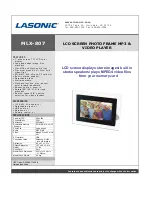
MicroVista Camera User Manual
ICD0057 Rev 1
6
Imaging Support: [email protected] http://www.mosir950.com 408-496-2019
Shutter device goes immediately from the last row of a frame to the first row of the
next frame. In Pseudo-Snapshot mode, the device instead waits for a period of
time after reading the last row before starting the first row of the next frame.
During this waiting period, the entire device is being exposed at the same time,
like a snapshot shutter. After the waiting period, rolling shutter readout resumes.
For example, a MicroVista
®
is put in Pseudo-Snapshot mode with an exposure
time of 50 ms. The Rolling Shutter readout time for the MicroVista
®
is 33.33 ms. If
the frame begins at time 0, then the first row will be exposed for time t=0.00 to
t=50.00 ms; the second row will be exposed for time t=0.03 to t=50.03 ms, and the
last row will be exposed for time t=33.30 to t=83.30 ms. From time t=33.30 to
t=50.00 ms, all rows are exposing at the same time.
Motion Artifacts
Due to the way rolling shutter reads out, it is susceptible to certain motion
artifacts. Since each row sees a slightly different time slice, fast moving objects
can get stretched out. Objects moving from left to right or right to left will be
slanted in the direction of motion. Objects moving from top to bottom will be
elongated, and objects moving from bottom to top will be shortened.
Rolling Shutter Frame Rate
In Rolling Shutter mode, it is possible to lower the frame rate (increase exposure
time) without resorting to Pseudo-Snapshot mode. Increasing the interline delay
(reset time for each row) will increase the time it takes to go from one row to the
next, and thus the total readout time for a frame. For example, the minimum row
blanking time of 3.45
μ
s plus the 29.09
μ
s of row readout gives a frame rate of 30
fps (33.33 ms) for 1024 rows. Increasing the row blanking time to 166.23
μ
s will
increase the readout time to 200.01 ms for 1024 rows for a frame rate of 5 fps.
Windowing
The MicroVista
®
is capable of changing the size of the image area that is read out.
Setting a specific window in the image allows the camera to read out that
particular portion of the image area at a much higher frame rate than a full frame.
The size and location of the window are defined by the starting row and column
and ending row and column of a rectangle. The only restrictions on the window
parameters are that the starting and ending column must be between 1 and 1280
and divisible by 8, and the starting and ending row must be between 1 and 1024.







































